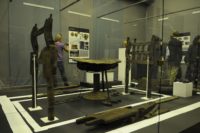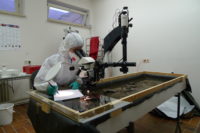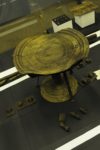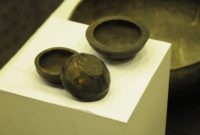 It was a find of international importance: the richly furnished grave of a Germanic prince dating to the early Migration Period, ca. 380 A.D., discovered during construction at Poprad-Matejovce, northeastern Slovakia, in 2006. Its double-chamber structure made it unique in the archaeological record from this period, and it was dense with well-preserved organic materials — the logs of the outer chamber, the timber platform it rested upon, the wooden sarcophagus that formed the inner chamber, furnishings, textiles, leather accessories.
It was a find of international importance: the richly furnished grave of a Germanic prince dating to the early Migration Period, ca. 380 A.D., discovered during construction at Poprad-Matejovce, northeastern Slovakia, in 2006. Its double-chamber structure made it unique in the archaeological record from this period, and it was dense with well-preserved organic materials — the logs of the outer chamber, the timber platform it rested upon, the wooden sarcophagus that formed the inner chamber, furnishings, textiles, leather accessories.
It was such a complex find and archaeologists had so little time to excavate that they had to take the whole thing out en bloc. Not in one single giant block of as German archaeologists would do with the Celtic Princess of the Danube in 2010, but in a Jenga-like network of 25 blocks. An astonishing ten tons of materials was removed to the State Archaeological Museum in Schleswig, northern Germany, for excavation. To prevent the fragile organic materials in the soil from decomposition or mold growth over the years it would take to excavate them, the blocks were frozen and kept at -20C.
 Between 2008 and 2015, 15 of the blocks were excavated in laboratory conditions that kept the environment cool and moist. In 2010, the block that contained the floor of the inner chamber was excavated. Four boards five feet long were dug out of the thick clay that was peeled back layer by layer under a medical microscope using tweezers, scalpels and needles.They recovered pieces of wood furniture, leather, wool, linen, twill and gold threads. They also recovered about 80 well-preserved bones of the young man buried there.
Between 2008 and 2015, 15 of the blocks were excavated in laboratory conditions that kept the environment cool and moist. In 2010, the block that contained the floor of the inner chamber was excavated. Four boards five feet long were dug out of the thick clay that was peeled back layer by layer under a medical microscope using tweezers, scalpels and needles.They recovered pieces of wood furniture, leather, wool, linen, twill and gold threads. They also recovered about 80 well-preserved bones of the young man buried there.
The positions of the finds indicate they were scattered when the tomb was looted in antiquity. The robbers cut the upper beams of the chamber and broke into the inner sarcophagus. They took almost all of the precious metal artifacts, save for a gold pendant made of a solidus of the Emperor Valens (375 A.D.), a gold fitting and the silver rivets of a wood sofa. We know this happened at most a few years after the burial because the skeleton was still articulated when the grave was looted.
 Whatever riches they deprived of us, they gifted us with everything else, an immense archaeological treasure that was only preserved because of the water that flooded the grave after they broke into it leaving the tomb in almost anaerobic condition for about 1,600 years. If it weren’t for the looters making off with the gold, we wouldn’t have the double-chamber tomb, large parts of a wood sofa and table turned on a lathe, a unique Roman board game, pottery, a wicker basket containing a food offering, a bronze bucket, more than 92 pieces of leather plus a full leather quiver and a variety of textiles including more than 150 fragments of multicolored slit tapestry textiles.
Whatever riches they deprived of us, they gifted us with everything else, an immense archaeological treasure that was only preserved because of the water that flooded the grave after they broke into it leaving the tomb in almost anaerobic condition for about 1,600 years. If it weren’t for the looters making off with the gold, we wouldn’t have the double-chamber tomb, large parts of a wood sofa and table turned on a lathe, a unique Roman board game, pottery, a wicker basket containing a food offering, a bronze bucket, more than 92 pieces of leather plus a full leather quiver and a variety of textiles including more than 150 fragments of multicolored slit tapestry textiles.
Meanwhile, every kind of analysis you can think of has been done on the contents of the grave — radiocarbon dating, isotope analysis, dendrochronological, DNA — and the latest results obtained from the skeletal remains indicate the man had Hepatitis B and likely died of the liver infection caused by the virus. He was between 25 and 30 years old.
 The contents of the inner chamber have been stabilized and are at the Archaeological Institute of the Slovak Academy of Sciences. The outer chamber is in the process of being dried with a new PEG-based method that was customized for this tomb. The aim is to have the tomb on permanent display at Podtatranská Museum in Poprad where it was discovered, but that has been repeatedly postponed. The latest proposed date for the installation in next year some time.
The contents of the inner chamber have been stabilized and are at the Archaeological Institute of the Slovak Academy of Sciences. The outer chamber is in the process of being dried with a new PEG-based method that was customized for this tomb. The aim is to have the tomb on permanent display at Podtatranská Museum in Poprad where it was discovered, but that has been repeatedly postponed. The latest proposed date for the installation in next year some time.
That looks like a fantastic turned spool/sleigh bed with horses-heads carved on the headposts. It would be good to see a conjectural reconstruction of it.
Maybe, we should recline over this for dinner :yes:
A ‘triclinium’ is a formal dining room in a Roman building (from Greek τρικλίνιον, triklinion, with τρι-, tri-, “three”, and κλίνη, klinē, a sort of couch or rather chaise longue). Our young migration period ‘eternal diner’ was therefore provided with a ‘monoclinium’ (of course, plus the table).
The approach was often a rather blunt one: In the Gautreks Saga, King Víkarr is hanged and then punctured by a spear; his executioner says “Now I give you to Odin” (to take part in the afterlife at the table, people strictly needed to have died in battle).
From experience I can report that a liver transplantation also counts as ‘battle’, i.e. a much better organized one.
Having HepB virus doesn’t mean you die of it. I wonder why they are pushing this conclusion.
I’m struck by the open window above the head of the scientist looking through the microscope. Wouldn’t letting outside air/moisture touch the remnants help destroy them???